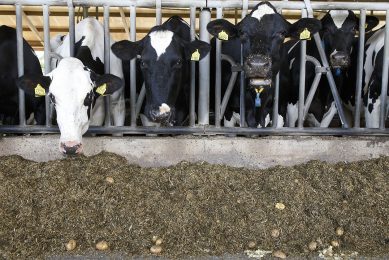Grain and hay mix keeps cows fed
Feeding grain with limited hay may not keep cows happy, but it will get them through the winter, according to Gary Naylor, a livestock specialist with University of Missouri Extension.
Limited rainfall, winter storms, frigid temperatures and the farmer’s
decision to not purchase record high fertilizer have limited the supply of hay
this year.
“US cattle producers are faced with tough decisions. The first
step would be to get rid of non-productive, open cows. There are always a few
cows that can be culled to make more feed available for the productive ones,”
said Naylor. The next step for producers who need to stretch their hay supply is
to estimate the size of their bales, the weight of their cows and calves and the
remaining days of feeding.
Feeding hay
“The
rule-of-thumb for feeding hay is that a cow will eat 2.5 pounds of hay per one
hundred pounds of body weight. A 1,000-pound cow will eat about 25 pounds of hay
a day,” said Naylor.
Cows can get by on half the hay fed normally, but the
protein and energy must be made up with grain or grain by-products. “This
1,000-pound cow in late gestation needs two pounds of protein and 11 pounds of
total digestible nutrients per day to stay healthy and produce a quality calf,”
said Naylor.
Make the ration cheaper
The grain would cost about 50
cents per day, while additional hay could cost as much as 65 to 70 cents, making
it cheaper to feed limited hay and more of a grain mix. Dried distillers grains,
a by-product of the ethanol industry and soy hulls, are a good source of
reasonably priced and high quality protein and energy, according to
Naylor.
Related link:
University of Missouri
Extension
To subscribe to the free AllAboutFeed newsletter click here.











